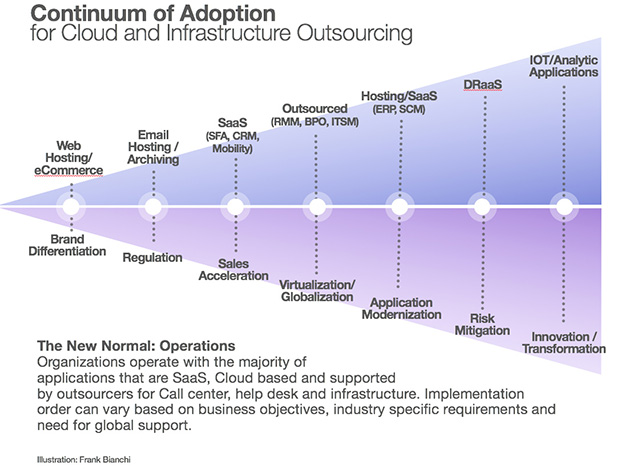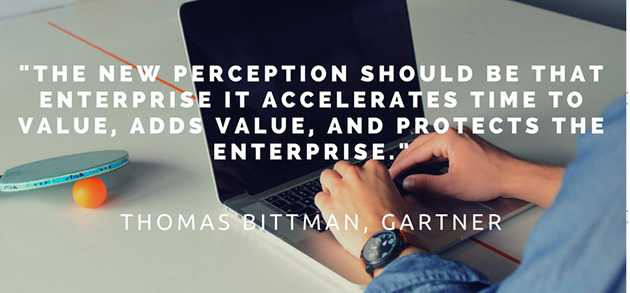Topics
How Business Drives the Pace of Cloud and Outsourcing Adoption

To people who aren’t on the IT side, infrastructure can have a tendency to seem abstract. They know it’s something that money is spent on, but they might not realize how, exactly, infrastructure supports a business as it scales and pursues different strategic activities. For its part, IT can have a reputation, fair or not, for focusing on the technical aspects of systems more than how they will power a company’s growth. It can be helpful for everyone to take a step back in order to understand the changing needs of growing, dynamic companies and how IT infrastructure can support those needs.
It’s possible to outline a basic maturity model that matches strategic activities and needs to the infrastructure they require. We’ve done just that, as you can see below:

This is, of course, a model – not all businesses will necessarily progress along this path in this order, or even hit all the steps along it, but it provides a general guide to what infrastructure requirements companies find themselves with based on strategic aims or needs.
- At the most fundamental level, there’s the need to be able to establish and differentiate a brand. A robust web presence is now essential to this and that in turn requires web hosting and eCommerce solutions for B2B and B2C models.
- Companies that are growing, or present in certain sectors, can run into certain compliance and e-Discovery requirements, necessitating the ability to archive emails and other communications. The migration to Office365 and similar models have made it quite easy to transition email servers to the cloud.
- Businesses that enter into periods of sales acceleration will need solutions that facilitate that growth, such as CRM platforms or sales force automation tools. The explosive use of Salesforce.com and other tools offered in a SaaS model made time-to-market easier.
- As an organization begins to diversify geographically, its infrastructure needs will grow more complex: Teams across locations will require tools that permit them to communicate and collaborate effectively. With access to the Internet as the only requirement for cloud access, we've seen increased adoption.
- Many companies are now realizing the benefits of transitioning their mission-critical applications such as ERP or supply chain management (SCM) software to an outsourced or hosted environment. This development is accelerated by the 24x7 nature of global business, the need for high availability and performance with robust disaster recovery capabilities.
- Beyond that, advanced needs, such as requirements for risk mitigation, become more and more critical, and businesses require advanced data recovery capabilities. The Disaster Recovery as a Service (DRaaS) and Backup as a Service (BaaS) offerings are growing exponentially, especially in the SMB market where current capabilities are often not sufficient.
- And finally, companies look to innovate via analytics applications for big data or the Internet of things, all of which demand its own infrastructure and houses both structured and unstructured data. This is certainly the area that will continue to evolve with analytics as a service leveraging the data in order to monetize or achieve a desired business outcome.
The role of IT as a value driver
This image is meant to convey in a straightforward way how business needs for cloud and infrastructure outsourcing develop as a company matures. Working from a shared understanding of how IT helps drive business success sets the table for better working relationships and more effective purchasing decisions. It can change the perception of IT as a “support” function to one that drives ROI.

As Gartner vice president Thomas Bittman said at Gartner's annual data center management summit in December 2015, “Ultimately, IT has to change the perception of IT in the business customers’ eyes: IT slows and weighs us down and says ‘no.’ The new perception should be that enterprise IT accelerates time to value, adds value, and protects the enterprise.”
If businesses comprehend how infrastructure underpins their ability to grow, pursue and achieve strategic goals, IT becomes central to organizational success. It also increases ROI pressures for decisions made by and with the input of IT leadership – they become an integral part of strategic procurement or outsourcing decisions along with business and finance. As a partner, the bar has been raised from maintenance to optimization including improving service while lowering costs. IT leadership will be required to:
- Provide high service quality for employees and customers
- Provide high system availability and performance
- Drive continuous, measured improvement and cost savings
- Prevent IT security breaches
- Introduce thought leadership on new and emerging technologies that can further differentiate the business
All the decisions that need to be made in terms of IT infrastructure as a business grows – meaning, all the different steps on the chart above – must address short-term ROI considerations as well as questions of long-term strategic viability for maximum value. Whether you’re considering establishing infrastructure in-house, outsourcing it to a partner that acts as an extension of the in-house team, or moving it to the cloud, you need to take into account not only where the business is, but where it’s going. Sometimes outsourcing certain applications can be an interim step toward moving to the cloud.
As digital transformations accelerate, the demands on IT, and the opportunity to create value, will only increase. Gartner’s Christy Petty stated: “If they haven’t already, I&O (infrastructure and outsourcing) leaders must ready themselves and their organizations for a culture of experimentation, innovation and deployment of new technologies. CIOs are being given the opportunity to lead digital transformation more and more, but they must adapt their leadership style to build a network of digital leadership inside and outside the enterprise.”
One sure thing is that the cloud is here to stay, and businesses should develop a plan that aligns outsourcing and cloud hosting as key enablers to achieve business objectives at the desired price point and risk mitigation. Companies will increasingly need to focus on their core competency while leveraging partners to manage infrastructure and host applications in private, public or hybrid environments.
